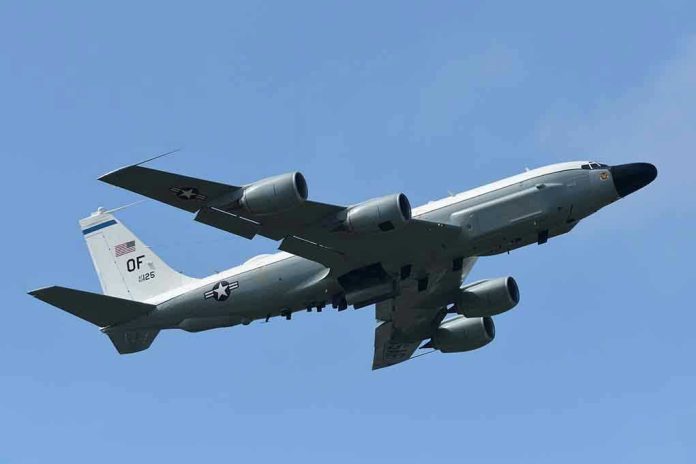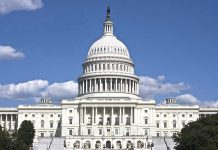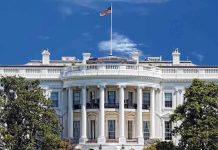
The world watched as American B-1B bombers roared near Venezuela’s coastline—an unmistakable message delivered in broad daylight, with transponders blazing and intentions anything but covert.
Story Snapshot
- U.S. B-1B bombers conducted high-profile flights near Venezuela, overtly signaling military pressure on the Maduro regime.
- Officially labeled as counter-narcotics operations, the move coincided with escalating tensions and open-source evidence contradicting presidential denials.
- Strategic bombers joined carrier strike groups and advanced jets, amplifying U.S. force projection across the southern Caribbean.
- The operation’s timing and transparency raised questions about American objectives, Venezuelan resilience, and the risk of entangling foreign powers.
America’s Bombers Mark a New Chapter in Caribbean Power Plays
On October 23, 2025, two B-1B Lancer bombers thundered from Dyess Air Force Base, Texas, heading straight for the waters off Venezuela. Their flight path hugged the mainland and skirted the Los Testigos islands, while support from KC-135 tankers and RC-135 reconnaissance aircraft ensured they showed up on every radar. The Pentagon wasted no time confirming the operation, framing it as part of ongoing regional missions under U.S. Southern Command. The bombers flew with their transponders activated—no attempt at stealth, just deliberate signaling. This was not a covert incursion; it was a broadcast.
The White House responded with rapid-fire denials. President Trump publicly dismissed reports that he had authorized the flights, even as open-source flight data and air traffic control audio told a different story. Defense Secretary Pete Hegseth doubled down on the official narrative, announcing recent airstrikes against suspected drug trafficking targets and citing the mission’s counter-narcotics objectives. The timing, transparency, and scale of the flights suggested more than drug interdiction; they hinted at a calculated escalation designed to pressure Nicolás Maduro’s government and signal U.S. resolve to adversaries near and far.
Escalation, Signaling, and Strategic Context
The B-1B operation was the latest in a series of aerial and naval maneuvers aimed at Venezuela. Just days earlier, B-52 bombers had traced similar paths near the country’s airspace. The USS Gerald R. Ford Carrier Strike Group patrolled the Caribbean, and the region bristled with advanced fighter jets and surveillance platforms. Official explanations leaned heavily on counter-narcotics missions, but defense analysts saw broader strategic signaling, especially as Russian and Iranian support for Venezuela intensified. The bombers’ open transponder broadcasts served as a billboard—a deliberate invitation for Venezuela (and its allies) to take notice.
Washington’s strategy appeared focused on isolating Maduro, reassuring regional partners, and deterring the growing influence of foreign powers. The Caribbean Sea, a critical artery for global narcotics trafficking, provided convenient justification for expanded military activity. Yet the scale and visibility of the deployments exceeded what counter-narcotics operations required, hinting at layered motives: deterrence, intimidation, and readiness to escalate if forced.
Regional Ramifications and the Risk of Miscalculation
Venezuelan officials denounced the flights as provocative and a violation of sovereignty, while allied commentators warned of creeping American intervention. Civilian populations across Venezuela and neighboring states watched with unease as the skies filled with the world’s most advanced bombers. U.S. military superiority in the region was unquestioned, but the risk of miscalculation—an incident, a misunderstanding, a sudden escalation—loomed over every sortie. Regional trade and maritime activity slowed, humanitarian organizations braced for potential fallout, and energy markets ticked upward, wary of instability at the continent’s edge.
Defense analysts and scholars weighed in, noting the precedent of using strategic bombers for political signaling in Latin America. Some argued that overt pressure could harden Maduro’s resolve and complicate diplomatic solutions, while others saw the flights as a necessary demonstration of American power in an era of resurgent great-power rivalry. Amid conflicting statements and swirling speculation, one fact stood clear: the bombers had flown, the signal was sent, and the region was watching.
Sources:
UK Defence Journal: American B-1B bombers approach Venezuela
The War Zone: B-1 Bombers Fly Off Venezuela’s Coast













